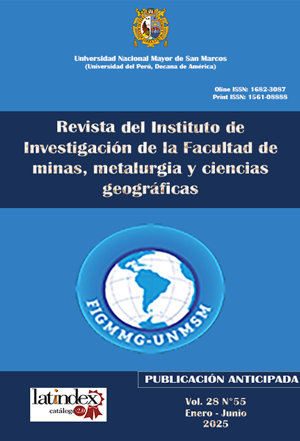Ecological Niche Modeling of Alouatta seniculus in the Alluvial Flood Forest,Lote 95
DOI:
https://doi.org/10.15381/iigeo.v28i55.29367Keywords:
ecological niche modeling, Alouatta seniculus, Normalized Difference Vegetation Index (NDVI), MaxEnt, habitatAbstract
This research aims to model the ecological niche of Alouatta seniculus in the floodplain alluvial forest ecosystem of Lot 95, expressing the results in values ranging from 0 to 1. A value of 0 indicates unfavorable conditions for the species' distribution, while a value of 1 represents optimal conditions.
Likewise, the Normalized Difference Vegetation Index (NDVI) was evaluated from multispectral images (Landsat 2022) to identify habitat quality based on the optimal vegetation index for Alouatta seniculus.
The results of the study showed that ecological niche modeling, using the MaxEnt model, predicted that the suitable distribution of Alouatta seniculus is concentrated in the northern part of the Lot 95 study area. This indicates that these geographic areas are favorable for its habitat, with a total area of 34,159.44 hectares and a range greater than 0.75.
Furthermore, in areas with a moderately healthy vegetation index, Alouatta seniculus occupies an area of 330,120.23 hectares, which represents its primary habitat.
References
Aguilar-Soto, V., Melgoza-Castillo, A., Villarreal, Guerrero, F., Wehenkel, C., & Pinedo-Alvarez, C. (2015). Modeling the potential distribution of Picea chihuahuana Martínez, an endangered species at the Sierra Madre Occidental, México. Forests, 6(3), 692–707. https://www.mdpi.com/1999-4907/6/3/692
Bravo E. (2007). Los impactos de la explotación petrolera en ecosistemas tropicales y la biodiversidad. Acción Ecológica. Disponible en: https://www.oilwatch.com
Chang, S. E., J. Stone, K. Demes, and M. Piscitelli. 2014. Consequences of oil spills: a review and framework for informing planning. Ecology and Society 19(2): 26. http://dx.doi.org/10.5751/ES-06406-190226
Hernández, B., Herrera, E., Cabrera., Delgado, A., Salazar, V., Bustamante, A., Campos, J. y Ramírez, J. (2016). Distribución potencial y características geográficas de poblaciones silvestres de Vanilla planifolia (Orchidaceae) en Oaxaca, México. Revista Biología Tropical, 64(1), 235-246. https://revistas.ucr.ac.cr/index.php/rbt/article/view/17854
Gómez, A. 2010. Aplicación de técnicas de análisis espacial, reducción de datos y modelado predictivo al estudio de la distribución espacial de especies. [Tesis doctoral, Universidad de Extremadura]
Honorio, E. N.; Vega, J. E. y Corrales, M. N. (2015). Diversidad, estructura y carbono de los bosques aluviales del noreste peruano. Folia Amazónica. 24(1), 55-70. https://revistas.iiap.gob.pe/index.php/foliaamazonica/article/view/59
International Tanker Owners Pollution Federation. (2022). Economic effects. https://www.itopf.org/knowledge-resources/documents-guides/economic-effects/
J. Farifteh, R. R. Struthers, R. Swennen y P. Coppin. Plant spectral and thermal response to water stress induced by regulated deficit irrigation, International Journal of Geosciences and Geomatics, vol. 1, no. 1, pp. 17-22, 2013.
León A., Zúñiga M., (2020). La sombra del petróleo: Informe de los derrames petroleros en la Amazonía peruana entre el 2000 y el 2019. Oxfam América Inc.
Morales, N. (2012). Modelos de distribución de especies: Software MaxEnt y sus aplicaciones en conservación. Revista Conservación Ambiental, 2(1), 1-3.
Osinfor (2013). Modelamiento espacial de nichos ecológicos para la evaluación de presencia de especies forestales maderables en la Amazonía peruana. Lima: Osinfor. 82 p.
Peterson, C. H., Rice, S. D., Short, J. W., Esler, D., Bodkin, J. L., Ballachey, B. E., & Irons, D. B. (2003). Long-term ecosystem response to the Exxon Valdez oil spill. Science, 302(5653): 2082-2086.https://doi.org/10.1126/science.1084282
Phillips, S.J.; Dudík, M. 2008. Modeling of species distributions with MaxEnt: New extensions and a comprehensive evaluation. Ecography 31, 161–175. https://doi.org/10.1111/j.0906-7590.2008.5203.x
Downloads
Published
Issue
Section
License
Copyright (c) 2025 Zarahi Ninfa Valer Ortiz

This work is licensed under a Creative Commons Attribution 4.0 International License.
AUTHORS RETAIN THEIR RIGHTS:
a. Authors retain their trade mark rights and patent, and also on any process or procedure described in the article.
b. Authors retain their right to share, copy, distribute, perform and publicly communicate their article (eg, to place their article in an institutional repository or publish it in a book), with an acknowledgment of its initial publication in the Rev. Inst. investig. Fac. minas metal cienc. geogr.
c. Authors retain theirs right to make a subsequent publication of their work, to use the article or any part thereof (eg a compilation of his papers, lecture notes, thesis, or a book), always indicating the source of publication (the originator of the work, journal, volume, number and date).






